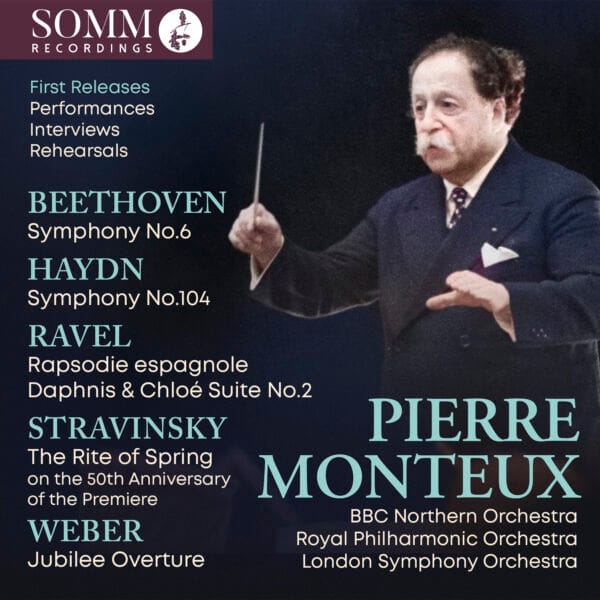
This is a remarkable two-CD set comprised entirely of first releases including never-before-issued performances led by the renowned conductor Pierre Monteux. Among these is a legendary 50th Anniversary performance of Stravinsky’s Rite of Spring with the composer in attendance, given a half-century to the day after Monteux himself conducted the storied Paris world premiere! The concert was broadcast live on the BBC from the Royal Albert Hall and performed by the London Symphony Orchestra
The esteemed Paul Baily is responsible for Audio Restorion and Remastering, and does a fine job.
SOMM explain the final bonuses on this twofer:
This set also commemorates the revered conductor – on the 60th anniversary of his death and ahead of the 150th anniversary of his birth – with moving testimony from LSO musicians involved in the landmark Stravinsky concert. These interviews were recorded between 1992 and 1995 by this set’s producer, Jon Tolansky, co-founder of Music Preserved and the author of documentary features on composers and performers. Monteux is also heard speaking on tape here, in a 1955 interview and a 1959 rehearsal of the LSO in Dvořák’s Seventh Symphony, providing a window onto the man’s intellect, work ethic and rapport with fellow musicians.”
It is mice to hear some Weber, and the Jubilee Overture has all of that composer’s fingerprints: pure mid-Romantic vivacity, certainly in this performance. Monteux even finds hints of Weber’s dark side at the trombone descent, a side excursion into Freischütz territory, perhaps. And of couse it ends in a blaze of a tune that everyone in the United Kingdom, at least, will know … after which Monteux taks it into a headlong final flourish. This is with the BBC Northern Orchestra, precursor to the BBC Philharmonic:
The Beethoven “Pastoral” is again with the BBC Northern, but with a shift of venue (Weber, Manchester Town Hall, Beethoven BBC Studios) . These might not be the newest of recordings , and both from airchecks, but detail still comes through: woodwind turns in tuttis are still audible, for example. Monteux’s reading of the first movement, “Erwachen heiterer Empfindingen bei der Ankunft auf dem Lande.” is fresh and really quite thrilling :
The second movement is not really a slow movement here, and all the better for it. Its freshness is directly related to that of the first movement, and while it remains an air check so there are more disciplined accounts, there is an underlying lyricism here that is most appealing: it really does sound as if the brook is singing!. The bird imitations towards the end are a little disjoining, they sound a touch deflated however:
The third movement boasts buoyant woodwind, gruff cellos and double-basses and music dances aplenty. it is something of a rustic riot! I’m reminded of Bruno Walter stomping his foot on the podium in the Ländler of Mahler’s Ninth; one can imagine Monteux doing the same here, were he in demonstrative mood.
There’s also his command of rhythm and structure: he has no need for over-rubato, he hardly slows down for structural nodes and yet there is no sense of rushing. Remarkable!:The finale I find a touch hard-driven.
The first disc ends with two pieces by Ravel. First Rapsodie espagnole, from the same concert, opening with a simply beautiful “Prélude à la nuit”. what clarinet playing; what a realisation f Ravel’s use of gesture from Monteux; what gossamer stages in their slow descents. This is some of the most perfect Ravel I have heard:
The “Malagueña” has real verve, contrasting wit the sultry, seductive “Habanera”:
… but passages in the finale seem to prefigure the wild energy of the “Rite” that is to come on the second disc (after some Haydn!):
The final piece on disc 1 is the Ravel Daphnis et Chloé Suite No. 2. we heard this recently in London, at the Royal College of Music (and if you follow this link you can find not only the aisle, but the YouTube stream of the entire concert, which included Tubin’s remarkable double-bass concerto). We also covered the entire ballet on Chandos with the Sinfonia of London and John Wilson here, a performance I descrbed at the time as “a performance for the ages”. The Suite No. 2 offers a Ravelian snapshot, but Monteux’s performance is possibly immersive. The high string melodies in “Léver du jour” are silken and beautiful. This is presented as one track; worth noting thatch clarinet soloist is one Jack Brymer, one of the most amazing of British soloists:
The Haydn is of its time when it comes to the slower sections and movements, and yet the falser music feels lightly sprung and buoyant. The firs movement exemplifies these traits in its contrast between the opening Adagio and the main body’s Allegro:
But the Andante is certainly pre-HIP:
I do, however, find the “Schwung” of the Menuetto irresistible. The way Monteux teases his way into the Trio, too, has great appeal, and then the sheer evenness of delivery coupled with maximal charm is terrific:
There’s a distinctly peasant elementalism to some of this symphony performance, not least in the finale:
Some readers might know Monteux’s recorded Haydn. It is true the Royal Philharmonic is not the Vienna Philharmonic, but the conception remains close to that of Monteux’s Vienna recording of No. 101:
And so to the Rite, a performance some half century since the infamous premiere (also conducted by Monteux). This is a performance of grandeur but also verve; the amount of detail and Monteux’s clear grasp of every aspect of the score is everywhere apparent. There is an omnipresence of dance here, too, even in the more hieratic moments like “Spring Rounds”:
The music hurtles towards the end of Part I, but what is truly impressive is how Stravinsky’s layering is so audible: no wonder this piece is so often linked to Birtwistle’s Earth Dances, the “Rite of Spring for the second half of the twentieth century”: Birtwistle uses a similar technique with his vast orchestra:
No wonder the audience goes nuts at the very end (we get the BBC announcement, too): Monteux, he said, conduced without score; and the composer is found in “box 7,” applauding along at the Royal Albert Hall. The second part is just as remarkable, Monteux always having the famous “Sacrifical Dance” in view form the first note. And that final panel has all of the spirit of the dance; just a vey primal dance:
There follows a sequence of recollections (“Souvenirs of an Icon”) courtesy of Hugh Maguire (former leader of the LSO) Gervase de Peyer (former principal clarinet), Erich Gruenberg, James Holland (former principal timpanist) and others, and two micro-snppets of a rehearsal of Dvorák 7.
A most valuable release.
This wonderful twofer is available at Amazon here. Streaming below.








